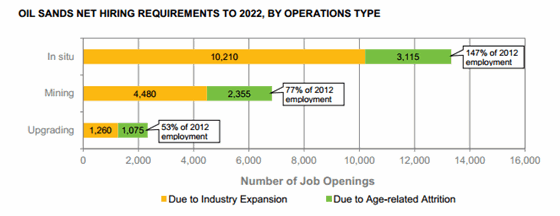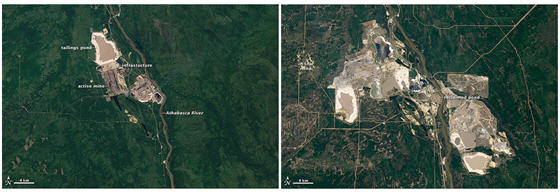Oil sands needs to grow workforce 70 pct over next decade: study
Even if expansion plans in Alberta’s oil patch falls short due to hydraulic fracturing in the US, the oil sands will have room for 38,300 new workers by 2022, says the Petroleum HR Council of Canada that released a labour study on Thursday.
The study authors said turnover, retirement and industry expansion will create the openings.
Over the coming decade, the oil sands operations workforce is projected to grow by 71 per cent over current levels, adding 16,000 direct new jobs and increasing employment to 38,300 workers by 2022.
In the short-term, employment in 2013 is expected to continue to grow, and the sector will add 2,850 new jobs. Mining and upgrading employment will increase by 14 per cent, adding 1,270 and 615 new jobs respectively. In situ employment is projected to grow by 11 per cent or 965 new jobs.
In the longer term, the majority of investment and production increases are attributed to in situ operations. As a result, in situ operations will more than double today’s workforce, adding 10,210 new jobs by 2022 and employing half of the oil sands workforce with 19,290 jobs. Mining employment is expected to be relatively flat until 2018 but will eventually increase to 13,400 jobs by 2022 – adding 4,480 new jobs over the next decade. Upgrading operations will add another 1,300 jobs, for a total workforce of approximately 5,640 by 2022.
In situ operations will have the highest net requirements, followed by mining and then upgrading.

Chart from Oil Sands Labour Demand Outlook to 2022 authored by Petroleum Human Resources Council of Canada
Mining activity is where the oil sands reserves are accessed through open pit mines. In situ activities is oil recovery via drills and wells, and upgrading is converting the bitumen into a product with a lower density and viscosity.
About 85% of the total oil sands workforce is located on site in Fort McMurray. The remaining 15% is located in head offices like Edmonton and Calgary.
Satellite image from NASA Earth Observatory. Photograph of oil pump by Paul Lowry
More News
{{ commodity.name }}
{{ post.title }}
{{ post.date }}


Comments